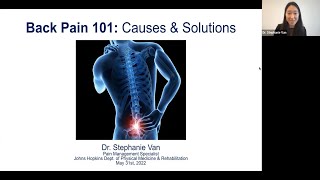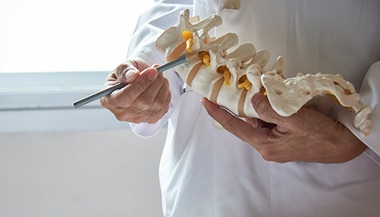7 Ways to Treat Chronic Back Pain Without Surgery
Featured Expert:
Back pain is considered chronic if it lasts three months or longer. It can come and go, often bringing temporary relief followed by frustration. Dealing with chronic back pain can be especially trying if you don’t know the cause.
Back pain rehabilitation specialist Stephanie Van, M.D., offers insights into common chronic back pain causes and nonsurgical treatment options — and she advises not to give up hope.
Common Causes of Chronic Back Pain
Chronic back pain is usually age-related, but it can also result from an injury. The most common causes include:
- Arthritis of the spine — the gradual thinning of the cartilage inside the spine
- Spinal stenosis — narrowing of the spinal canal that may lead to nerve pain
- Disk problems, such as a herniated or bulging disk
- Myofascial pain syndrome — muscle pain and tenderness without clear cause
In some cases, it is difficult to pinpoint the cause of chronic back pain.
“If your doctor has explored all diagnostic and treatment options they are comfortable with, consider seeking a second opinion from a back pain specialist,” Van recommends.
It is important to understand the source of your pain as much as possible, and to consider every available, reasonable option. People with back pain should not feel rushed into settling for an invasive, irreversible surgical procedure. Surgery can be helpful for many people, but it is usually considered a last resort after more conservative options have been exhausted. Surgery can correct structural abnormalities contributing to back pain, but it does not guarantee pain relief, and it may even worsen the pain, Van warns. If the source of the pain is not known or can’t be treated, the best strategy is to collaborate with your doctor on a pain management plan that reduces the severity and frequency of flare-ups and focuses on goals for function and quality of life.
Back Pain Causes and Treatments Webinar | Stephanie Van, M.D.
Chronic back pain is a persistent source of discomfort for many adults. In this webinar, our expert Stephanie Van, M.D., discusses common causes of back pain along with strategies for relief.
Physical Therapy and Home Exercise Program
Exercise is the foundation of chronic back pain treatment. It’s one of the first treatments you should try, under the guidance of your physician and spine physical therapist. However, one set of exercises does not work for everyone, says Van. Prescribed exercises can and should be tailored to your specific symptoms, condition and comfort level. Maintaining your exercise routine regularly at home is even more important than the work you do during the physical therapy — a consistent regimen is the key to maintaining the spine’s strength and stability.
Physical therapy for chronic back pain may include:
- Core strengthening
- Stretching and flexibility exercises
- Retraining posture
- Testing the limits of pain tolerance
- Aerobic exercises at a comfortable pace
Mindfulness and Meditation
Chronic back pain is both physically and emotionally straining. To manage the frustration, irritability, depression and other psychological aspects of dealing with chronic pain, you may get referred to a rehabilitation psychologist. This specialist may recommend meditation, yoga, tai chi and other cognitive and relaxation strategies to boost your conscious control over your nervous system and its response to activity.
Diet Change
Some diets are highly inflammatory, especially those high in trans fats, refined sugars and processed foods. Consult with your doctor to see if your diet could be contributing to your chronic back pain and how you could change it. Maintaining a healthy weight could also help lessen back pain by reducing pressure on your spine. Referral to a nutrition specialist is the best way to get personalized advice for strategies to access more balanced foods and to develop eating habits that support your health goals.
Lifestyle Modifications
There are many ways to adapt and adjust your behavior and activity that can significantly improve chronic back pain before even considering medications or procedures.
“Listen to your body and learn to pace yourself,” suggests Van. Take breaks when doing strenuous chores, and make several trips or ask for help when carrying heavy or multiple objects such as groceries. Take note of the activities that worsen your pain and avoid them, if possible, while engaging more with activities you find comfortable and enjoyable. Not only could this help your back feel better, but it may also prevent the underlying condition from advancing. It’s also important to consider minimizing harmful habits like smoking, which is proved to heighten pain and delay healing. Focus on one realistic goal that you can achieve comfortably and consistently before addressing another lifestyle change.
Injection-based Treatments
Trigger point injections, epidural steroid injections, nerve blocks, nerve ablations and other types of injection-based procedures are available for chronic back pain. These procedures are considered when the source of the pain is known, and they can sometimes help rule out certain causes if the treatment does not work. Injections may stop or lessen pain for a while, but they are not intended as long-term solutions and shouldn’t be used in isolation. The goal of injection-based treatments is to improve pain control and maximize your participation in regular gentle activity such as physical therapy and home exercises.
Alternative Treatments
Acupuncture, massage, biofeedback therapy, laser therapy, electrical nerve stimulation and other nonsurgical spine treatments can make a difference for chronic back pain. Overall, the potential benefits of these strategies far outweigh their potential risks, so they are worth exploring. Talk to your spine specialist about alternative treatments that could help you.
Pharmacologic Treatments
All kinds of medicines (topical, oral, injectable) are used to help manage chronic back pain, including anti-inflammatories, muscle relaxants, nerve pain medications and even antidepressants. However, any medication can have unwanted side effects. Work with your doctor to explore medication strategies that directly address the cause of your pain (if it is known). Find the lowest effective dose to minimize side effects, and use medications only for as long as they are helpful and well-tolerated.
“Opioid medications are not recommended as a first-line strategy for chronic back pain,” Van says. “They are most helpful in the short term for acute pain, like after a traumatic accident or surgery, because they act to shut down pain signaling temporarily without addressing a root cause of pain, like inflammation. Past the expected healing period, opioids should be phased out and nonopioid medications should be maximized to achieve pain control long term. Prolonged use of opioids is so stigmatized because it inevitably leads to medication tolerance, escalating to higher and riskier doses, physical dependence and habit formation.”
Opioids should be prescribed only after first-line and second-line pain medications have been tried without providing relief. If you find yourself relying on opioids to get through the day and you have not been offered many alternatives, it may be time to seek a second opinion.
When is surgery a good idea for back pain?
If you suddenly start experiencing any of the following “red flag” symptoms, it might be time for surgery, if the symptoms found to be related to your spine condition:
- New or worsening bowel/bladder issues (incontinence, groin numbness)
- Weakness in limbs
- Gait and balance problems
- Evidence of increased (brisk) reflexes
Surgery can also be an option for chronic back pain if a cause is confirmed by imaging and if other treatments have not helped.
“Surgery is the most invasive, high risk strategy for chronic back pain,” Van says. “It is irreversible, and it does not guarantee complete relief of back pain. The best spine surgeons will offer surgery only after the patient has tried and has not had success with conservative treatments. Consider consulting with more than one surgeon so you can make the most informed decision about your options.”








